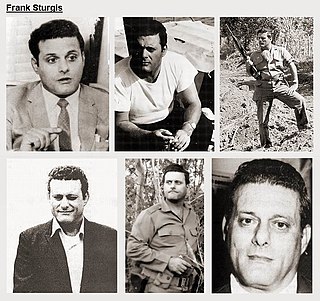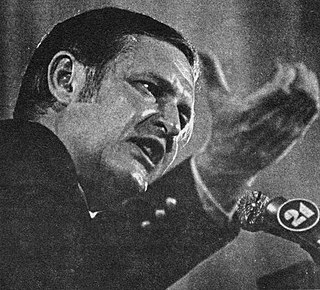Related Research Articles

Howard Robard Hughes Jr. was an American aerospace engineer, business magnate, film producer, investor, philanthropist, and pilot. He was best known during his lifetime as one of the richest and most influential people in the world. He first became prominent as a film producer, and then as an important figure in the aviation industry. Later in life, he became known for his eccentric behavior and reclusive lifestyle—oddities that were caused in part by his worsening obsessive-compulsive disorder (OCD), chronic pain from a near-fatal plane crash, and increasing deafness.

The Watergate scandal was a major political scandal in the United States involving the administration of President Richard Nixon from 1972 to 1974 that led to Nixon's resignation. The scandal stemmed from the Nixon administration's attempts to cover up its involvement in the June 17, 1972, break-in of the Democratic National Committee headquarters in Washington, D.C., at the Watergate Office Building.

Harry Robbins "Bob" Haldeman was an American political aide and businessman, best known for his service as White House Chief of Staff to President Richard Nixon and his consequent involvement in the Watergate scandal.

James Walter McCord Jr. was an American CIA officer, later head of security for President Richard Nixon's 1972 reelection campaign. He was involved as an electronics expert in the burglaries which precipitated the Watergate scandal.

Frank Anthony Sturgis, born Frank Angelo Fiorini, was one of the five Watergate burglars whose capture led to the end of the presidency of Richard Nixon.

Everette Howard Hunt Jr. was an American intelligence officer and author. From 1949 to 1970, Hunt served as an officer in the Central Intelligence Agency (CIA), where he was a central figure in U.S. regime change in Latin America including the 1954 Guatemalan coup d'état and the 1961 Bay of Pigs Invasion in Cuba. Along with G. Gordon Liddy, Frank Sturgis, and others, Hunt was one of the Nixon administration so-called White House Plumbers a team of operatives charged with identifying government leaks to outside parties.

Louis Patrick Gray III was acting director of the Federal Bureau of Investigation (FBI) from May 3, 1972, to April 27, 1973. During this time, the FBI was in charge of the initial investigation into the burglaries that sparked the Watergate scandal, which eventually led to the resignation of President Nixon. Gray was nominated as permanent Director by Nixon on February 15, 1973, but failed to win Senate confirmation. He resigned as Acting FBI director on April 27, 1973, after he admitted to destroying documents that had come from convicted Watergate conspirator E. Howard Hunt's safe—documents received on June 28, 1972, 11 days after the Watergate burglary, and given to Gray by White House counsel John Dean.

Deep Throat is the pseudonym given to the secret informant who provided information in 1972 to Bob Woodward, who shared it with Carl Bernstein. Woodward and Bernstein were reporters for The Washington Post, and Deep Throat provided key details about the involvement of U.S. president Richard Nixon's administration in what came to be known as the Watergate scandal. In 2005, 31 years after Nixon's resignation and 11 years after Nixon's death, a family attorney stated that former Federal Bureau of Investigation (FBI) Associate Director Mark Felt was Deep Throat. By then, Felt was suffering from dementia and had previously denied being Deep Throat, but Woodward and Bernstein then confirmed the attorney's claim.

The White House Plumbers, sometimes simply called the Plumbers, the Room 16 Project, or more officially, the White House Special Investigations Unit, was a covert White House Special Investigations Unit, established within a week of the publication of the Pentagon Papers in June 1971, during the presidency of Richard Nixon. Its task was to stop and/or respond to the leaking of classified information, such as the Pentagon Papers, to the news media. The work of the unit "tapered off" after the bungled "Ellsberg break-in" but some of its former operatives branched into illegal activities while still employed at the White House together with managers of the Committee to Re-elect the President, including the Watergate break-in and the ensuing Watergate scandal. The group has been described as Nixon's "fixers".

The Watergate Seven has come to refer to two different groups of people, both of them in the context of the Watergate scandal. Firstly, it can refer to the five men caught on June 17, 1972, burglarizing the Democratic National Committee's headquarters in the Watergate complex, along with their two handlers, E. Howard Hunt and G. Gordon Liddy, who were Nixon campaign aides. All seven were tried before Judge John Sirica in January 1973.

Jack Northman Anderson was an American newspaper columnist, syndicated by United Features Syndicate, considered one of the founders of modern investigative journalism. Anderson won the 1972 Pulitzer Prize for National Reporting for his investigation on secret U.S. policy decision-making between the United States and Pakistan during the Indo-Pakistani War of 1971. In addition to his newspaper career, Anderson also had a national radio show on the Mutual Broadcasting System, acted as Washington bureau chief of Parade magazine, and was a commentator on ABC-TV's Good Morning America for nine years.

The Watergate scandal refers to the burglary and illegal wiretapping of the headquarters of the Democratic National Committee, in the Watergate complex by members of President Richard Nixon's re-election campaign, and the subsequent cover-up of the break-in resulting in Nixon's resignation on August 9, 1974, as well as other abuses of power by the Nixon White House that were discovered during the course of the scandal.

Francis Donald Nixon was a younger brother of U.S. President Richard Nixon.
David Sánchez Morales was a Central Intelligence Agency operative who worked in Cuba and Chile.
William King "Bill" Harvey was an American Central Intelligence Agency (CIA) officer, best known for his role in the terrorism and sabotage campaign known as Operation Mongoose. He was known as "America's James Bond", a tag given to him by Edward Lansdale.
Robert Aime Maheu was an American businessman and lawyer, who worked for the FBI and CIA, and as the chief executive of Nevada operations for the industrialist Howard Hughes.
Robert Mullen Company was a public relations company in Washington DC. The firm was founded in 1952 by Robert R. Mullen, who was a campaign press secretary for Dwight D. Eisenhower and information director for the Marshall Plan. A Watergate committee report revealed that the Robert Mullen Company had in at least two instances been a front for CIA operations abroad, in addition for former CIA intelligence case officer and head of the White House plumbers E. Howard Hunt.
The CIA Kennedy assassination is a prominent John F. Kennedy assassination conspiracy theory. According to ABC News, the Central Intelligence Agency (CIA) is represented in nearly every theory that involves American conspirators. The secretive nature of the CIA, and the conjecture surrounding the high-profile political assassinations in the United States during the 1960s, has made the CIA a plausible suspect for some who believe in a conspiracy. Conspiracy theorists have ascribed various motives for CIA involvement in the assassination of President Kennedy, including Kennedy's firing of CIA director Allen Dulles, Kennedy's refusal to provide air support to the Bay of Pigs invasion, Kennedy's plan to cut the agency's budget by 20 percent, and the belief that the president was weak on communism.

Family of Secrets is a book by Russ Baker. Published by Bloomsbury Press in 2008, it describes alleged connections between the Bush family and the Central Intelligence Agency. The book asserts that President George H.W. Bush was linked to the Watergate scandal and the assassination of John F. Kennedy. Family of Secrets was poorly received by critics.
Hughes Dynamics, Inc. was an American computer firm that was a wholly owned subsidiary of the Hughes Tool Company. It existed from 1962 to around 1965. It offered consulting and services in data processing, information technology, credit information processing, and advanced business techniques and management methods. One mid-1963 description given to a trade industry publication was that Hughes Dynamics provided a "broad range of research and consulting services in management sciences and information technology; operations research, systems analysis and design, computer programming and operations, [and] market research" and that its business model involved "consultation with businesses, industries, governments, [and] institutions [as well as] fee for services". It staged a rapid growth from mid-1962 to early 1964, primarily through acquisitions, but then just as quickly shut itself down and dispersed its businesses. The role of Howard Hughes in all this is somewhat unclear.
References
- ↑ Bellett, Gerald (1995). Age of Secrets: The Conspiracy that Toppled Richard Nixon and the Hidden Death of Howard Hughes. Voyageur North America.
- 1 2 Barlett, Donald L.; James B. Steele (2004). Howard Hughes: His Life & Madness. W.W Norton and Company. p. 401.
- ↑ "CIA may have used contractor who inspired 'Mission: Impossible' to kill RFK, new book alleges". The Washington Post. February 9, 2019.
- ↑ "Hughes, Nixon and the CIA: The Watergate Conspiracy Woodward and Bernstein Missed", Playboy, September 1976
- ↑ "Filming Intimate Howard Hughes", USA Today , October 2, 1998
- ↑ "Howard Hughes' Private Mr. Clean", Los Angeles Herald Examiner, November 9, 1969
- ↑ "Hughes, Nixon and the CIA: The Watergate Conspiracy Woodward and Bernstein Missed". Playboy Magazine. September 1976.
- ↑ "John Meier the man to see about any of Howard Hughes operations", New York Daily Column, October 1, 1969
- 1 2 "Nevada town hides Hughes secret", Columbian (Canada), March 3, 1976
- ↑ "John Meier is Unique in my book. He's the only gent I know that ever quit Howard Hughes", Las Vegas Sun, November 6, 1969
- ↑ The Mystery Behind the Break-In, Probe, January–February 1995
- ↑ Age of Secrets: The Conspiracy that Toppled Richard Nixon and the Hidden Death of Howard Hughes written by Gerald Bellett, 1995, Voyageur North America, ISBN 0-921842-42-2
- ↑ "CIA may have used contractor who inspired 'Mission: Impossible' to kill RFK, new book alleges". The Washington Post. February 9, 2019.
- 1 2 Barlett and Steele. Howard Hughes: His Life & Madness. pp. 404–405, 419.
- ↑ Barlett and Steele. Howard Hughes: His Life & Madness. p. 419.
- ↑ "Town could boom again", Columbian (Canada), March 4, 1976
- 1 2 3 Higham, Charles (2004). Howard Hughes: The Secret Life. MacMillan. p. 241.
- ↑ Van Fossen, Anthony (2006). "A New Howard Hughes: John Meier, Entrepreneurship, and the International Political Economy of the Bank of the South Pacific (Ivan Molloy and Ron Reavall, eds.)" (PDF). The Eye of the Cyclone Book 2: Governance and Stability in the Pacific. Noosa Heads, Queensland: The University of the Sunshine Coast and Rock Mountain Publishing. 2: 129–162. Retrieved 2008-02-27.
- ↑ Barlett and Steele. Howard Hughes: His Life & Madness. p. 422.
- ↑ "How I got the Hughes Papers" by John Reynolds, Canadian Review, June 1977
- ↑ Van Fossen, Anthony (2006). "A New Howard Hughes: John Meier, Entrepreneurship, and the International Political Economy of the Bank of the South Pacific (Ivan Molloy and Ron Reavall, eds.)" (PDF). The Eye of the Cyclone Book 2: Governance and Stability in the Pacific. Noosa Heads, Queensland: The University of the Sunshine Coast and Rock Mountain Publishing. 2: 129–162. Retrieved 2008-02-27.
The documents, which were supposed to be the detailed personal and financial records of Hughes and which were entered into court in his civil suit against the Hughes organisation, were considered by the court to include papers forged in Meier's Vancouver home.
- ↑ Bellett, Gerald (2022). Age of Secrets: The Conspiracy that Toppled Richard Nixon and the Hidden Death of Howard Hughes. ISBN 978-1-7782874-2-8.
- ↑ Pollution Big Health Menace, Las Vegas Sun, January 9, 1969
- ↑ Barlett and Steele. Howard Hughes: His Life & Madness. p. 409.
- ↑ "Index to Motion Picture Credits: Meier-Murray Productions". Academy of Motion Picture Arts and Sciences. Retrieved 2008-02-27.